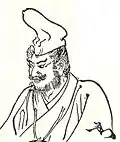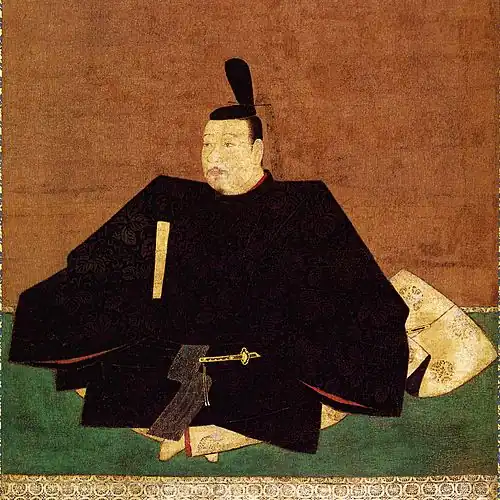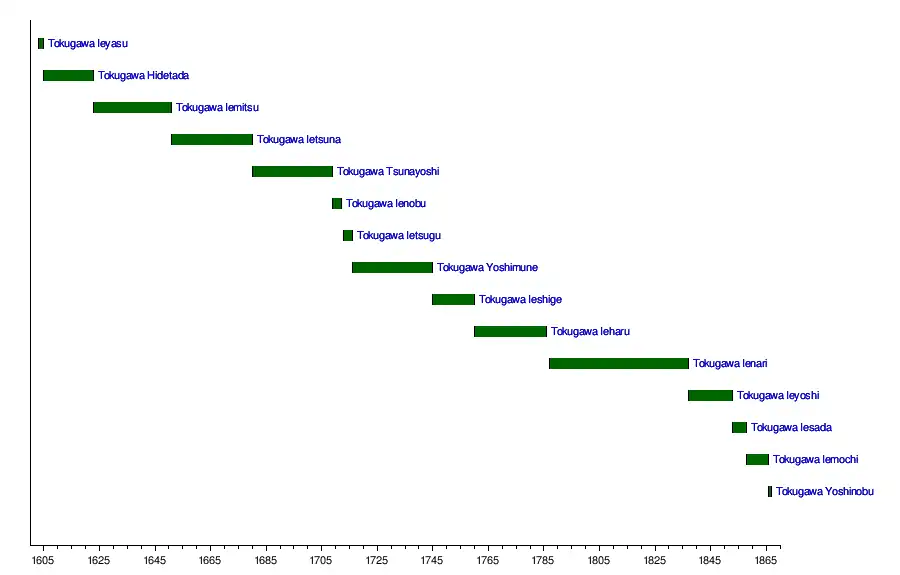List of shoguns
This article is a list of shoguns that ruled Japan intermittently, as hereditary military dictators,[1] from the beginning of the Asuka period in 709 until the end of the Tokugawa shogunate in 1868.[a]
Asuka / Heian periods (709–1184)
Note: there are different shogun titles. For example, Kose no Maro had the title of Mutsu Chintō Shōgun (陸奥鎮東将軍; lit. "Great General of Subduing Mutsu"). Ki no Kosami had the title of Seitō Taishōgun (征東大将軍; lit. "Commander-in-chief for the pacification of the East") [5] in 789 which is less important than Sei-i Taishōgun. Ōtomo no Otomaro was the first person who was granted the title of Seii Taishōgun (征夷大将軍; lit. "Great appeasing general of the barbarians"). Sakanoue no Tamuramaro was the second, and Minamoto no Yoritomo was third person who had the title of Sei-i Taishōgun.
| No. | Portrait | Name (birth–death) | Shogun from | Shogun until |
|---|---|---|---|---|
| 1 |  | Kose no Maro | 709 | |
| 2 |  | Tajihi no Agatamori | 720 | 721 |
| 3 |  | Ōtomo no Yakamochi (c. 718–785) | 784 | 785 |
| 4 |  | Ki no Kosami | 788 | 789 |
| 5 |  | Ōtomo no Otomaro (731–809) | 793 | 794 |
| 6 |  | Sakanoue no Tamuramaro (758–811) | 797 | 808 |
| 7 |  | Funya no Watamaro (765–823) | 811 | 816 |
| 8 |  | Fujiwara no Tadabumi (873–947) | 940 | |
| 9 |  | Minamoto no Yoshinaka (1154–1184) | 1184 | |
Kamakura shogunate (1192–1333)
| No. | Portrait | Name (birth–death) | Shogun from | Shogun until |
|---|---|---|---|---|
| 1 |  | Minamoto no Yoritomo (1147–1199) | 1192 | 1199 |
| 2 |  | Minamoto no Yoriie (1182–1204) | 1202 | 1203 |
| 3 |  | Minamoto no Sanetomo (1192–1219) | 1203 | 1219 |
| 4 |  | Kujō Yoritsune (1218–1256) | 1226 | 1244 |
| 5 |  | Kujō Yoritsugu (1239–1256) | 1244 | 1252 |
| 6 |  | Prince Munetaka (1242–1274) | 1252 | 1266 |
| 7 |  | Prince Koreyasu (1264–1326) | 1266 | 1289 |
| 8 |  | Prince Hisaaki (1276–1328) | 1289 | 1308 |
| 9 |  | Prince Morikuni (1301–1333) | 1308 | 1333 |
Timeline

Kenmu Restoration (1333–1336)
| No. | Portrait | Name (birth–death) | Shogun from | Shogun until |
|---|---|---|---|---|
| 1 |  | Prince Moriyoshi (1308–1335) | 1333 | |
| 2 |  | Prince Narinaga (1326 – c. 1337–44) | 1335 | 1336 |
Ashikaga shogunate (1336–1573)
| No. | Portrait | Name (birth–death) | Shogun from | Shogun until |
|---|---|---|---|---|
| 1 |  | Ashikaga Takauji (1305–1358) | 1338 | 1358 |
| 2 |  | Ashikaga Yoshiakira (1330–1367) | 1359 | 1367 |
| 3 |  | Ashikaga Yoshimitsu (1358–1408) | 1369 | de jure 1395 |
| de facto 1408 | ||||
| 4 |  | Ashikaga Yoshimochi (1386–1428) | 1395 | de jure 1423 |
| de facto 1428 | ||||
| 5 | Ashikaga Yoshikazu (1407–1425) | 1423 | 1425 | |
| 6 |  | Ashikaga Yoshinori (1394–1441) | 1429 | 1441 |
| 7 | Ashikaga Yoshikatsu (1434–1443) | 1442 | 1443 | |
| 8 |  | Ashikaga Yoshimasa (1436–1490) | 1449 | de jure 1474 |
| de facto 1490 | ||||
| 9 |  | Ashikaga Yoshihisa (1465–1489) | 1474 | 1489 |
| 10 |  | Ashikaga Yoshitane (1466–1523) | 1490 | 1493 |
| 11 |  | Ashikaga Yoshizumi (1481–1511) | 1495 | 1508 |
| (10) |  | Ashikaga Yoshitane (1466–1523) | 1508 | 1522 |
| 12 |  | Ashikaga Yoshiharu (1511–1550) | 1522 | de jure 1547 |
| de facto 1550 | ||||
| 13 |  | Ashikaga Yoshiteru (1536–1565) | 1547 | 1565 |
| 14 | Ashikaga Yoshihide (1538–1568) | 1568 | ||
| 15 |  | Ashikaga Yoshiaki (1537–1597) | 1568 | deposed 1573 |
| abdicated 1588 | ||||
Timeline

Azuchi–Momoyama period (1568–1600)
The following were military dictators of Japan, de facto shoguns from 1568 to 1598. They unified the country, which at the start were a chaotic patchwork of warring clans.
| No. | Portrait | Name (birth–death) | de facto shogun from | de facto shogun until |
|---|---|---|---|---|
| 1 |  | Oda Nobunaga (1535–1582) | 1568 | de jure 1575 |
| de facto 1582 | ||||
| 2 | .jpg) | Oda Nobutada (1557–1582) | 1575 | 1582 |
| 3 | .jpg) | Oda Hidenobu (1580–1605) | 1582 | 1583 |
| 1 |  | Toyotomi Hideyoshi (1537–1598) | 1585 | de jure 1592 |
| de facto 1598 | ||||
| 2 |  | Toyotomi Hidetsugu (1568–1595) | 1592 | 1595 |
| 3 |  | Toyotomi Hideyori (1593–1615) | 1598 | de jure 1603 |
From 1598 to 1600, the de facto shogunate was delegated to the Council of Five Elders.
Tokugawa shogunate (1600–1868)
| No. | Portrait | Name (birth–death) | Shogun from | Shogun until |
|---|---|---|---|---|
| 1 | Tokugawa Ieyasu (1543–1616) | de facto 1600 | de jure 1605 | |
| de jure 1603 | de facto 1616 | |||
| 2 |  | Tokugawa Hidetada (1579–1632) | 1605 | de jure 1623 |
| de facto 1632 | ||||
| 3 |  | Tokugawa Iemitsu (1604–1651) | 1623 | 1651 |
| 4 |  | Tokugawa Ietsuna (1641–1680) | 1651 | 1680 |
| 5 |  | Tokugawa Tsunayoshi (1646–1709) | 1680 | 1709 |
| 6 |  | Tokugawa Ienobu (1662–1712) | 1709 | 1712 |
| 7 |  | Tokugawa Ietsugu (1709–1716) | 1713 | 1716 |
| 8 |  | Tokugawa Yoshimune (1684–1751) | 1716 | de jure 1745 |
| de facto 1751 | ||||
| 9 |  | Tokugawa Ieshige (1712–1761) | 1745 | de jure 1760 |
| de facto 1761 | ||||
| 10 |  | Tokugawa Ieharu (1737–1786) | 1760 | 1786 |
| 11 |  | Tokugawa Ienari (1773–1841) | 1787 | de jure 1837 |
| de facto 1841 | ||||
| 12 | Tokugawa Ieyoshi (1793–1853) | 1837 | 1853 | |
| 13 |  | Tokugawa Iesada (1824–1858) | 1853 | 1858 |
| 14 |  | Tokugawa Iemochi (1846–1866) | 1858 | 1866 |
| 15 |  | Tokugawa Yoshinobu (1837–1913) | 1866 | 1867[a] |
Timeline

Notes
- ^ a b The Tokugawa shogunate came to its official end on 9 November 1867, when Tokugawa Yoshinobu "put his prerogatives at the Emperor's disposal" and resigned 10 days later.[2] This was effectively the "restoration" (Taisei Hōkan) of imperial rule – although Yoshinobu still had significant influence and it was not until 3 January 1868, with the Emperor's edict, that the Meiji Restoration fully occurred.[3] On that day, the Emperor stripped Yoshinobu of all power and made a formal declaration of the restoration of his power.[4]
See also
References
- ^ "Shogun". Encyclopædia Britannica. Retrieved 10 June 2022.
- ^ "Meiji Restoration | Definition, History, & Facts". Encyclopedia Britannica. Retrieved 21 August 2017.
- ^ "One can date the 'restoration' of imperial rule from the edict of 3 January 1868." Jansen (2000), p. 334.
- ^ Quoted and translated in A Diplomat In Japan, Sir Ernest Satow, p. 353, ISBN 978-1-933330-16-7
- ^ Friday, 2007:108.
Bibliography
- Friday, Karl (2007). The First Samurai: The Life and Legend of the Warrior Rebel, Taira Masakado. John Wiley and Sons. ISBN 0-471-76082-X.